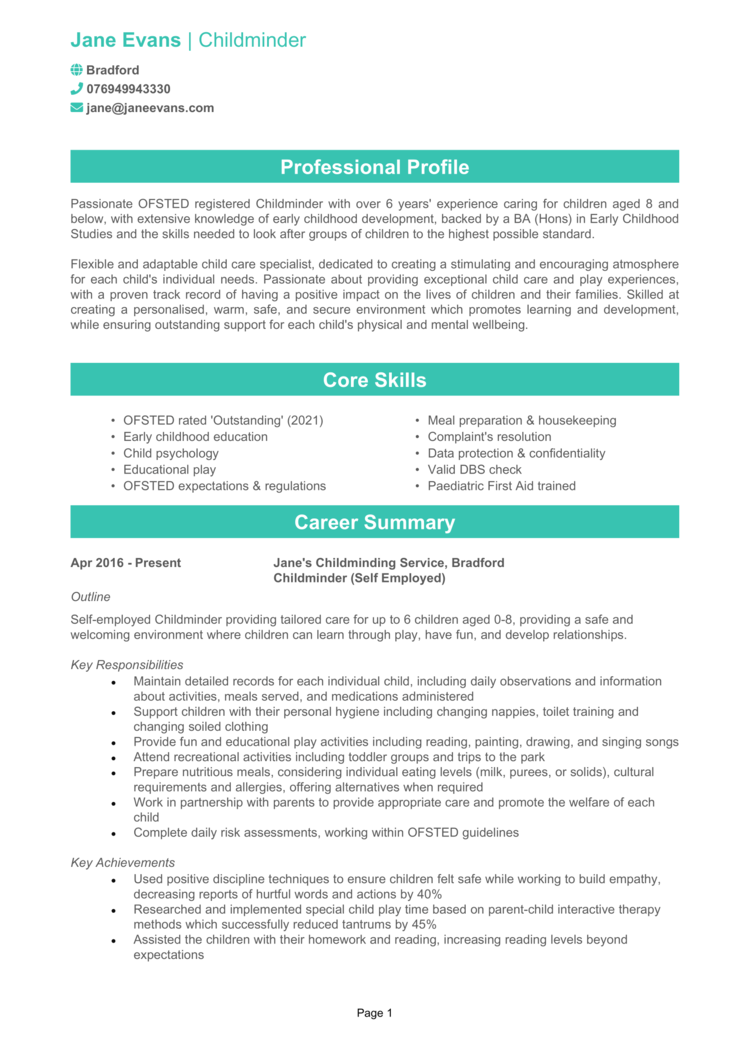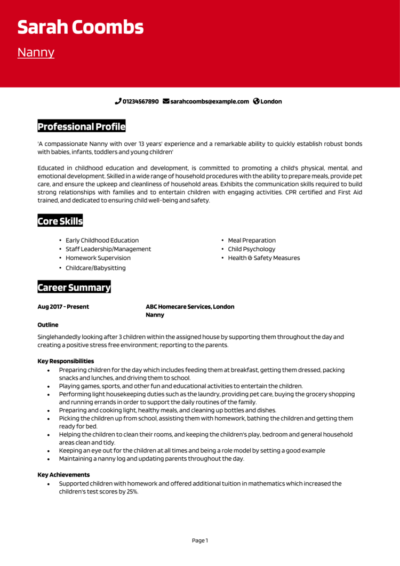As a nanny, you juggle the roles of teacher, chef, playmate, and sometimes peace negotiator – all while keeping little ones safe and happy. But before you can get along with the kids, you’ll need to impress the parents or agency with your CV.
This guide, complete with 2 great Nanny CV examples, will help you showcase your caregiving expertise, adaptability, and love for working with children in a way that ensures you can land your next role.
Nanny CV example

Childminder CV example

How to write your Nanny CV
Learn how to create your own interview-winning Nanny CV with this simple step-by-step guide.
A nanny’s CV is all about demonstrating your ability to provide exceptional care, build trust with families, and foster a positive environment for children.
These steps will help with writing a winning CV that highlights your childcare experience, key skills, and dedication to supporting children’s development.
Nanny CV structure


Your CV should be as organised and reliable as you are during a busy day of childcare (without any of the chaos). A clear and professional structure ensures that parents and employers can see your strengths at a glance.
Here’s how to structure your Nanny CV:
- Name and contact details – Place your personal details at the top so parents can reach you easily. Including a photo is optional, but it can add a personal touch.
- Profile – Start off with a brief overview of your childcare experience, approach to caregiving, and key attributes.
- Core skills – Concisely highlight abilities like managing routines, organising activities, and handling emergencies calmly, with a column of short bullet points.
- Work experience – Share your professional childcare history in reverse chronological order, focusing on the value you’ve brought to families.
- Education – Go through your qualifications, including any childcare-related certifications or training, or a degree.
- Additional info – This optional section can include hobbies and interests that reflect your creativity or commitment to child development.
Nanny CV format


Your CV should be as polished as the manners you’ve taught during mealtime. A clean and organised format, free from preventable mistakes, ensures your expertise stands out while keeping distractions to a minimum.
Here’s how to format your Nanny CV effectively:
- Bullet points – Make sure you break down your responsibilities and achievements into short, easy-to-read sections.
- Divide sections – Use clear headings and consistent formatting to make your CV layout easy to navigate.
- Use a clean font – Choose a font that’s professional and easy to read – no fancy frills.
- Keep it the right length – 2 pages are enough to showcase your qualifications and childcare experience while respecting the reader’s time.
What is a Nanny CV profile?


Your CV profile is your opportunity to connect with potential recruiters by showcasing your experience and approach to childcare. Let them see what benefit you’d bring to them and their children.
Nanny CV profile examples
Profile 1
Caring Nanny with five years of experience providing attentive childcare for families with children aged 1 to 10. Skilled in planning educational activities, managing daily routines, and ensuring a safe, nurturing environment. Proficient in meal preparation, school pick-ups, and maintaining strong parent communication.
Profile 2
Organised Nanny with three years of experience supporting families with infants and toddlers. Adept at managing feeding schedules, coordinating nap times, and fostering early developmental milestones. Experienced in light housekeeping and providing a structured yet fun environment for young children.
Profile 3
Experienced Nanny with over eight years of expertise in working with school-aged children, specialising in homework assistance, extracurricular support, and fostering independence. Skilled in managing household tasks, coordinating schedules, and building lasting relationships with children and their families.
What to include in your Nanny CV profile
Here are some tips to prove that you’re the Mary Poppins of the job market:
- Where you’ve worked – Tell the recruiter the types of families or settings you’ve provided care for, such as private households or nanny shares.
- Your top qualifications – Name any childcare-related certifications like a Level 3 Diploma in Childcare.
- Key childcare skills – Make clear abilities like managing schedules, organising creative activities, and handling conflicts effectively.
- Age groups you’ve cared for – Specify whether you’ve worked with toddlers, school-aged children, or infants.
- Relevant tools or methods – Mention approaches like Montessori techniques or experience with child safety equipment.
Core skills section


Your core skills section is like your nanny bag – it should include everything you need to handle the day successfully. This section gives parents a quick overview of your abilities, from keeping schedules on track to fostering emotional growth.
Top skills for your Nanny CV
- Childcare Expertise – Providing attentive, compassionate care for children of various age groups.
- Routine Management – Creating and maintaining schedules for meals, naps, and activities to ensure a structured day.
- Creative Activities – Organising engaging, age-appropriate games and crafts to support learning and development.
- Conflict Resolution – Managing sibling disagreements or meltdowns calmly and effectively.
- Health and Safety Awareness – Ensuring children’s environments are safe and responding quickly to emergencies.
- Educational Support – Assisting with homework and reinforcing school learning through educational activities.
- Nutritional Meal Prep – Preparing healthy, child-friendly meals and snacks to meet dietary needs.
- Travel Assistance – Accompanying families on trips or school runs while ensuring children’s safety.
- Behaviour Management – Using positive reinforcement techniques to encourage good behaviour.
- Infant Care – Providing specialised care for babies, including feeding, changing, and developmental milestones.
Describing your work experience


Your work experience section is where you showcase how you’ve applied your childcare skills in real-world settings. Highlight families or households you’ve worked with and the outcomes you achieved.
Not every nanny starts with a long list of professional gigs. If you’ve been babysitting your cousins or running the school’s aftercare programme, it all counts – so list it with confidence.
Writing job descriptions for past roles

- Outline – Describe the family or setting, your role, and the age groups you cared for.
- Responsibilities – Focus on tasks like meal preparation, creating routines, or assisting with developmental milestones.
- Achievements – Include measurable results, such as improving a child’s learning progress or helping them develop new skills.
How to present past roles for Nannies
Nanny | Bright Family Care
Outline
Provided full-time childcare for two children aged 4 and 7, ensuring their safety, education, and well-being. Supported the family by managing daily routines and fostering a stimulating environment.
Responsibilities
- Planned and facilitated educational activities to support cognitive and social development.
- Assisted with homework and school projects, promoting academic success.
- Prepared nutritious meals and snacks tailored to dietary preferences.
- Organised outings to parks, museums, and other recreational venues.
- Maintained open communication with parents regarding daily activities and milestones.
Achievements
- Improved school performance by 15 percent through consistent homework support.
- Reduced household stress by managing children’s daily schedules independently.
- Praised by parents for creating a nurturing and engaging environment.
Nanny | Growing Minds Homecare Services
Outline
Provided part-time care for a toddler, focusing on developmental milestones and early learning activities. Supported the family by ensuring a safe and structured routine.
Responsibilities
- Prepared bottles and meals according to dietary needs and feeding schedules.
- Developed age-appropriate activities to foster motor skills and language development.
- Ensured a clean and safe play environment by maintaining toys and spaces.
- Coordinated nap schedules to align with the child’s needs and family routines.
- Supported light housekeeping tasks, including laundry and tidying up after meals.
Achievements
- Promoted early language development, leading to a 25 percent increase in vocabulary within six months.
- Received consistent praise from parents for reliability and adaptability.
- Helped transition the toddler to a regular sleep schedule, reducing night-time disruptions.
Nanny | Little Steps Agency
Outline
Provided after-school care for three children aged 8, 10, and 12, supporting academic and extracurricular activities. Ensured a smooth household routine while fostering independence.
Responsibilities
- Supervised homework completion and provided tutoring in maths and reading.
- Prepared after-school snacks and meals for the family.
- Coordinated transportation to and from extracurricular activities and events.
- Organised the children’s schedules, ensuring alignment with school and family commitments.
- Encouraged responsibility by assigning age-appropriate household tasks.
Achievements
- Improved time management skills for all three children by introducing structured schedules.
- Increased family satisfaction by maintaining a balanced routine and reducing conflicts.
- Built strong relationships with the children, resulting in a long-term position with the family.
Education section


The education section is where you list your academic background and childcare-related certifications. Include qualifications like a Level 3 Diploma in Childcare or First Aid training.
For those newer to the field, highlight coursework, volunteering, or training that demonstrates your potential.
Always list qualifications in reverse chronological order, starting with the most recent.
Key qualifications for a Nanny
- Level 3 Diploma for the Early Years Workforce – Training focused on childcare and early development.
- Paediatric First Aid Certification – Ensures you’re equipped to handle emergencies involving children.
- CACHE Level 2 Certificate in Childcare and Education – Covers essential knowledge for working with children.
- Enhanced DBS Check – Confirms your suitability for working with children.





